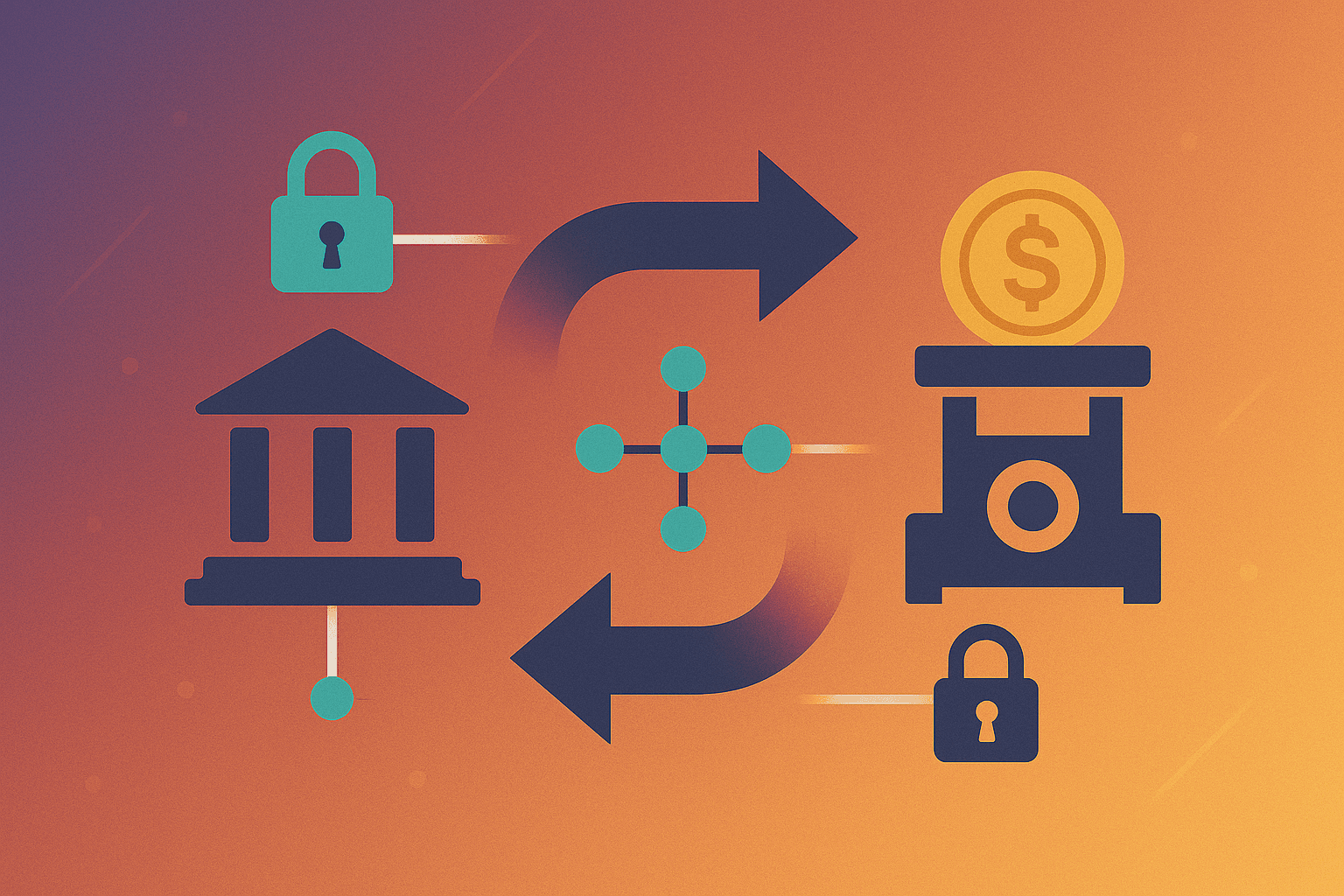The GENIUS Act just passed the Senate 68-30, and while everyone's talking about who will issue stablecoins, the real opportunity is in building the infrastructure that makes them useful.
The Senate passed the landmark GENIUS Act on June 17, 2025, establishing the first comprehensive federal framework for stablecoins. But here's what most analysis is missing: while the Act allows banks to issue stablecoins, it specifically restricts them from offering yield directly on stablecoin balances - creating a massive opportunity for infrastructure partnerships instead.As Treasury Secretary Scott Bessent predicts the U.S. stablecoin market could grow nearly eightfold to over $2 trillion in the next few years, the question isn't who will mint the tokens - it's who will build the programmable infrastructure that makes stablecoins actually useful for business banking and treasury management.
GENIUS Act Creates Infrastructure Opportunity, Not Issuance Race
The Regulatory Reality: Banks Can Issue, But Can't Optimize
The GENIUS Act establishes three types of permitted stablecoin issuers: subsidiaries of insured depository institutions, federal qualified nonbank issuers, and state-qualified issuers. What the legislation doesn't do is give banks the tools to make stablecoins productive beyond basic transfers.
What Banks Can Do Under GENIUS Act:
Issue compliant, fully-reserved stablecoins
Maintain reserves backed 1:1 with US coins, currency, Treasury bills, or deposits at insured institutions
Accept stablecoins for customer payments
Provide monthly reserve disclosures and annual audits
What Banks Still Need Infrastructure For:
Programmable yield optimization (DeFi integration)
Automated treasury management and cash flow workflows
Smart contract-based escrow and conditional payments
Cross-border payment optimization
Integration with existing banking systems and compliance
This regulatory structure creates what we call the "infrastructure gap" - banks can issue stablecoins, but they need technology partners to make them useful for business operations.
Corporate Stablecoin Wave Validates Infrastructure-First Strategy
The GENIUS Act restricts non-financial large tech companies from directly issuing stablecoins unless they establish or partner with regulated financial entities. This doesn't stop corporate adoption - it channels it through infrastructure partnerships. Amazon and Walmart are reportedly spending $14 billion annually on card processing fees and exploring stablecoin alternatives. When news broke of corporate stablecoin exploration, Visa and Mastercard shares fell about 5% as investors realized the disintermediation potential. But corporate stablecoins face the same infrastructure challenge as bank-issued stablecoins: having a token ≠ having useful token infrastructure.
PayPal's PYUSD: The Infrastructure Lesson
PayPal's PYUSD captures only 0.0036% of the stablecoin market despite first-mover advantage. Why? Because PayPal built a token, not a comprehensive ecosystem for business treasury management, yield optimization, or programmable payments. JPMorgan is taking a different route with JPMD, a deposit token designed to function like a stablecoin but tightly integrated with traditional banking systems, available only to institutional clients with features like 24/7 settlement and interest payments. This illustrates the winning strategy: infrastructure that bridges traditional banking with programmable money features.
Business DeFi Infrastructure: Where the Real Revenue Lives
With $247 billion in stablecoin market cap and growing, businesses need more than basic send/receive functionality. They need stablecoin treasury management, crypto business account features, and programmable yield capabilities.
Why Infrastructure Beats Issuance for Revenue
Stablecoin Issuance Model:
High regulatory overhead and capital requirements
Revenue tied to float and reserve management
Competition on basis points and interest rates
Balance sheet intensive
Infrastructure Model:
SaaS-style recurring revenue from features
Platform fees for programmable functionality
Yield-sharing from treasury optimization
Asset-light, technology-focused scaling
The infrastructure play captures more sustainable value. Consider how Visa and Mastercard built trillion-dollar networks not by issuing currency, but by creating the rails that make payments work.
Real-World Stablecoin Infrastructure Use Cases
1. High-Yield Business Banking Accounts
Post-GENIUS Act, banks can offer stablecoin business accounts but need infrastructure to provide:
Automated DeFi yield deployment
Crypto treasury management
with risk controls
Integration with traditional accounting systems
Multi-signature governance for corporate accounts
2. Crypto Mobile Payments and Point-of-Sale
The crypto mobile payments market needs infrastructure for:
Accept any token, settle in preferred stablecoin
Instant yield deployment on received payments
Integration with existing merchant systems
Compliance and audit trails for business customers
3. Programmable Business Banking
Business DeFi infrastructure enables:
Automated supplier payments with escrow conditions
Dynamic discounting based on yield optimization
Cross-border payroll with instant settlement
Treasury automation and cash flow management
Partnership Model: Banks + Infrastructure = Market Capture
The most sophisticated institutions are recognizing this opportunity. JPMorgan's JPMD approach and the joint-bank stablecoin consortium signal that winners will combine banking relationships with technical infrastructure.
Technical Architecture for Bank-Infrastructure Partnerships
Layer 1: Bank Compliance and Custody
GENIUS Act-compliant stablecoin issuance
KYC/AML and regulatory reporting
Traditional ACH/wire integration
Customer relationship management
Layer 2: Infrastructure Provider Technology
Programmable smart accounts with yield optimization
DeFi integration (legally separated from bank operations)
Automated payment workflows and treasury management
API integrations with business systems
Layer 3: Customer Experience
Unified dashboard for traditional and stablecoin balances
White-labeled experience maintaining bank relationship
Integration with existing accounting and ERP systems
Seamless fiat on/off-ramp functionality
Market Evidence: Infrastructure Demand is Exploding
The data supports the infrastructure-first thesis:Enterprise Adoption: Nearly 1 in 5 of F500 executives say onchain initiatives are a key part of their company's strategy moving forward (up 47% year on year)
SMB Growth: One third of SMBs use crypto, twice as many as in 2024, with stablecoin usage doubling to 18%
Regulatory Certainty: 9 in 10 F500 executives agree that clear regulation in the US on crypto, blockchain, or web3 / onchain is needed to support innovation
Infrastructure Scaling: 245x year-on-year growth in real-world asset tokenization to over $21B in April 2025
Why Fortune 500 Companies Want Banking-Integrated Solutions
The demand signals are clear: businesses want stablecoin business account functionality, but they want it through their existing banking relationships, not through standalone crypto platforms. Fortune 500 companies are particularly interested in crypto treasury management solutions that integrate with their current financial operations rather than requiring entirely new vendor relationships.
This creates a perfect partnership opportunity where banks provide the regulatory compliance and customer relationships, while infrastructure providers deliver the programmable yield optimization and automated treasury features that make stablecoins valuable for business operations.
The Strategic Implications: Building for B2B2C
For companies building in this space, the GENIUS Act clarifies the winning strategy:
Focus on Bank Partnerships: Build infrastructure that banks can white-label and offer to their commercial customers
Regulatory Partnership: Work within GENIUS Act frameworks to enhance traditional banking relationships
Platform Thinking: Build infrastructure that works across multiple stablecoins and bank partnerships
Enterprise Features First: Prioritize compliance, audit trails, and integration capabilities over consumer features
Post-GENIUS Act Infrastructure Opportunities
Near-Term (Next 6 Months)
Bank partnership pilots for stablecoin business accounts
Corporate treasury management infrastructure
Merchant payment processing with instant yield
Integration platforms for existing business banking systems
Medium-Term (6-18 Months)
Multi-bank infrastructure platforms
Cross-corporate stablecoin interoperability
Advanced DeFi integration for business banking
International expansion following U.S. regulatory leadership
Long-Term (18+ Months)
Industry-standard programmable money infrastructure
AI-driven treasury optimization
Supply chain finance automation
Global stablecoin business banking networks
The Future: Multi-Stablecoin Infrastructure Layer
As the GENIUS Act moves to the House and corporate stablecoins proliferate, the infrastructure layer becomes even more valuable. Instead of banks building custom solutions for every stablecoin, they'll want unified platforms that handle bank-issued, corporate-issued, and traditional stablecoins through programmable interfaces.The GENIUS Act heads to the House, which has its own STABLE Act version, and reconciling the two could take time. But regardless of final details, the infrastructure opportunity is clear: banks want to offer stablecoin services, businesses want programmable money features, and infrastructure providers can capture the value layer between them.
Conclusion: The Infrastructure Moment is Now
The GENIUS Act's passage isn't just regulatory clarity - it's market validation for the infrastructure-first approach. Banks can now issue stablecoins, but they need partners to make them useful. Businesses want programmable money, but they want it through trusted banking relationships.The companies that recognize this shift will build the infrastructure layer that powers the next generation of business banking. They'll partner with banks rather than compete with them, and they'll capture sustainable platform revenue as stablecoins become the backbone of business treasury management.
The future isn't about who issues the most stablecoins - it's about who builds the infrastructure that makes stablecoins indispensable for business operations. With the GENIUS Act providing regulatory clarity, that future is starting now.
Ready to explore how stablecoin infrastructure can transform your business banking operations? The regulatory framework is in place - now it's time to build the infrastructure that makes programmable money a reality.



